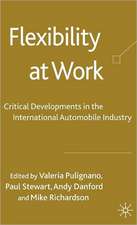Machinery Failure Analysis Handbook: Sustain Your Operations and Maximize Uptime
Autor Luiz Octavio Amaral Affonsoen Limba Engleză Hardback – noi 2006
Preț: 701.89 lei
Preț vechi: 871.96 lei
-20% Nou
Puncte Express: 1053
Preț estimativ în valută:
134.31€ • 140.58$ • 111.79£
134.31€ • 140.58$ • 111.79£
Carte tipărită la comandă
Livrare economică 24 martie-07 aprilie
Preluare comenzi: 021 569.72.76
Specificații
ISBN-13: 9781933762081
ISBN-10: 193376208X
Pagini: 308
Ilustrații: b/w photos & charts
Dimensiuni: 156 x 234 x 25 mm
Greutate: 0.63 kg
Editura: ELSEVIER SCIENCE
ISBN-10: 193376208X
Pagini: 308
Ilustrații: b/w photos & charts
Dimensiuni: 156 x 234 x 25 mm
Greutate: 0.63 kg
Editura: ELSEVIER SCIENCE
Cuprins
Preface
Part I Introduction to Failure Analysis
1 Fundamental Causes of Failures
1.1 Design Failures
1.2 Material Selection Deficiencies
1.3 Material Imperfections
1.4 Manufacturing Defects
1.5 Assembly and Installation Errors
1.6 Maintenance and Operation Errors
Conclusion
2 Failure Analysis Practice
2.1 Failure Analysis Objectives
2.2 How Far Should We Go?
2.3 Main Steps
2.4 Reports and Databases
3 Failure Prevention Efforts
3.1 Types of Failure
3.2 Prevention of Failures
3.3 Machinery Monitoring and Anticipatory Action
3.4 Operator’s Role in Machinery Reliability
Part II Failure Modes
4 Ductile and Brittle Fractures
4.1 Ductile Fracture Morphology
4.2 Ductile Fracture Mechanism
4.3 Brittle Fracture
4.4 Brittle Fracture Morphology
4.5 Brittle Fracture Mechanism
5 Fatigue Fractures
5.1 Fatigue Fracture Mechanism
5.2 Fatigue Fracture Surface Morphology
5.3 Factors That Influence Fatigue Strength
6 Wear
6.1 Sliding Wear
6.2 Hard Particle Wear
6.3 Liquid Impingement Wear
6.4 Cavitation
7 Corrosion
7.1 Electrochemical Corrosion Mechanism
7.2 Uniform Corrosion
7.3 Corrosion Fatigue
7.4 Pitting Corrosion
7.5 Galvanic Corrosion
7.6 Corrosion Erosion
7.7 Stress Corrosion Cracking
8 Incrustation
8.1 Coke Deposition
8.2 Salt Deposition
8.3 Biological Incrustation
9 Electric Discharge Damage
Part III Machinery Component Failures
10 Shafts
10.1 Stresses Acting on a Shaft
10.2 Fatigue Failures
10.3 Shaft Wear
10.4 Shaft Distortion
11 Hydrodynamic Bearings
11.1 Operation of a Hydrodynamic Bearing
11.2 Hydrodynamic Bearing Construction
11.3 Hydrodynamic Bearing Failure Analysis
11.4 Fatigue Failures
11.5 Bearing Metal Wear
11.6 Corrosion
11.7 Effect of Hard Particles on Bearings
11.8 Effect of Lubrication
11.9 Effect of Temperature
11.10 Effect of Overloads
11.11 Assembly Deficiencies
11.12 Electrical Discharge Damage
11.13 Fabrication-related Failures
11.14 Design-related Failures
12 Antifriction Bearings
12.1 Antifriction Bearing Lubrication
12.2 Antifriction Bearing Design Life
12.3 Contact Patterns on Bearing Races
12.4 Antifriction Bearing Failure Analysis
12.5 Types of Failure
13 Mechanical Seals
13.1 How a Mechanical Seal Works
13.2 Seal Mechanical Design
13.3 Seal Hydrodynamic Design
13.4 P × V
13.5 Sealing System
13.6 Mechanical Seal Failure Analysis
13.7 Face Contact Patterns
13.8 Failure Mechanisms and Causes
13.9 Corrosion of Seal Components
13.10 Mechanical Damage
13.11 Thermal Damage
13.12 Design and Manufacturing Defects
14 Bolts
14.1 How a Bolt Works
14.2 Application of the Preload
14.3 Reusing Bolts
14.4 Bolt Failure
15 Gears
15.1 Gear Tooth Contact and Lubrication
15.2 Loads Acting on the Gear Teeth
15.3 Gear Failure
16 Reciprocating Compressor Valves
16.1 How a Compressor Valve Works
16.2 Valve Failure
17 Belt Transmissions
17.1 “V Belts
17.2 Synchronized Belts
18 Couplings
18.1 Disc Coupling Couplings
18.2 Grid Couplings
18.3 Gear Couplings
18.4 Coupling Standardization
19 Turbomachinery Blades
19.1 How a Turbomachinery Blade Works
19.2 Blade Failure Analysis
Part IV Case Studies
20 Failure Analysis Examples
20.1 A Pump Failure Caused by Turbine Driver Overspeed
20.2 Hydrogen Compressor Seal Failure
20.3 Vibration-induced Fatigue Failures of Identical Reciprocating Compressors
20.4 A Gearbox Failure from the Electrical Discharge Damage of a Bearing
Bibliography
Index










